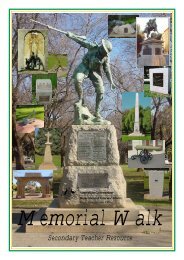The battle for Greece & Crete.pdf - Army Museum of South Australia
The battle for Greece & Crete.pdf - Army Museum of South Australia
The battle for Greece & Crete.pdf - Army Museum of South Australia
You also want an ePaper? Increase the reach of your titles
YUMPU automatically turns print PDFs into web optimized ePapers that Google loves.
To prevent this from happening Hitler ordered the preparation <strong>of</strong> the plans <strong>for</strong> “Operation Marita”which was a plan to invade and occupy Northern <strong>Greece</strong> commencing on the 26 March 1941.“Operation Marita”This invasion was to be undertaken by the German 12 th <strong>Army</strong> which consisted <strong>of</strong> 14 Divisionscommanded by Field Marshal von List these troops were currently engaged in nearby Yugoslavia.<strong>The</strong> build up by the alliesOn the 1 st March 1941 Bulgaria agreed to allow the Germans to occupy their country. It was duringMarch that the allies began to move troops into <strong>Greece</strong>. Between the 4 th and 18 th March, 58,000 troopsarrived in <strong>Greece</strong> and thereafter continued to arrive on a regular basis. Over 68,000 troops were to betransferred to <strong>Greece</strong> without loss.<strong>The</strong> Italian Navy consisting <strong>of</strong> a Battleship, eight cruisers and thirteen destroyers under the command<strong>of</strong> Admiral Angelo Iachino attempted to disrupt the landing <strong>of</strong> the allied troops and on the 27 th and 28 thMarch the Italian fleet was engaged by the British and <strong>Australia</strong>n Navies in the Battle <strong>of</strong> Cape Malapanwith the Italians being soundly defeated.<strong>The</strong> <strong>Australia</strong>ns<strong>The</strong> first contingent <strong>of</strong> troops <strong>of</strong> “Lustre Force” to arrive in <strong>Greece</strong> numbered 756 included 89 men <strong>of</strong>the 3 rd <strong>Australia</strong>n Casualty Clearing Station (ACCS). <strong>The</strong>se troops had left Alexandria (Egypt) onHMAS Perth and arrived at the port <strong>of</strong> Piraeus on the 8 th March 1941. <strong>Australia</strong>n troops continued toarrive regularly and were initially camped in the village <strong>of</strong> Dafni (the camps were named Daphne 1 andDaphne 2) which is between Piraeus and Athens be<strong>for</strong>e they moved north.<strong>Australia</strong>’s first casualty <strong>of</strong> the campaign occurred on the 1 st April 1941 when Sgt. Alec Moodie <strong>of</strong> the2/6 th Infantry Battalion, whilst carrying out Anti Aircraft (AA) duty aboard the MV Delos was killedduring a German Air attack.<strong>The</strong> Anzac TraditionOn the 12 th April General Blamey re<strong>for</strong>med the Anzac Corps with the troops <strong>of</strong> the 1 st <strong>Australia</strong>n Corpsand the New Zealand Division becoming known as the Anzac Corps thus reigniting the spirit <strong>of</strong> 1915.VolunteersWhen they arrived in <strong>Greece</strong> the <strong>Australia</strong>ns were greeted by the local population in a very unusualmanner, who had lined the roadside or leant out <strong>of</strong> their windows <strong>of</strong> their homes to wave to the Aussiesand they also gave them the ‘thumbs up’ which had been adopted by them after seeing the RAF use itto indicate “V <strong>for</strong> Victory”. <strong>The</strong> Greeks readily adopted this gesture and apparently it is now acceptedas part <strong>of</strong> a normal greeting in Athens. Of course the <strong>Australia</strong>ns had a rather different meaning <strong>for</strong> thisgesture. However, the ‘Diggers’ quickly realised that the Greeks saw the gesture as a sign <strong>of</strong>welcome and support. It would appear that this was another example <strong>of</strong> the easy going nature andlarrikinism <strong>of</strong> <strong>Australia</strong>ns, as we were able to change what was considered to be an insult into acompliment.<strong>The</strong> Greeks were quite surprised to find that both the <strong>Australia</strong>n and New Zealand troops were all‘volunteers’, because they had a difficulty in understanding the concept <strong>of</strong> ‘volunteerism’ in respect tothe military they believed that the <strong>Australia</strong>ns and the New Zealanders had volunteered to fight <strong>for</strong><strong>Greece</strong> – they considered them as ‘their soldiers’ and treated them as such.- 4 -











